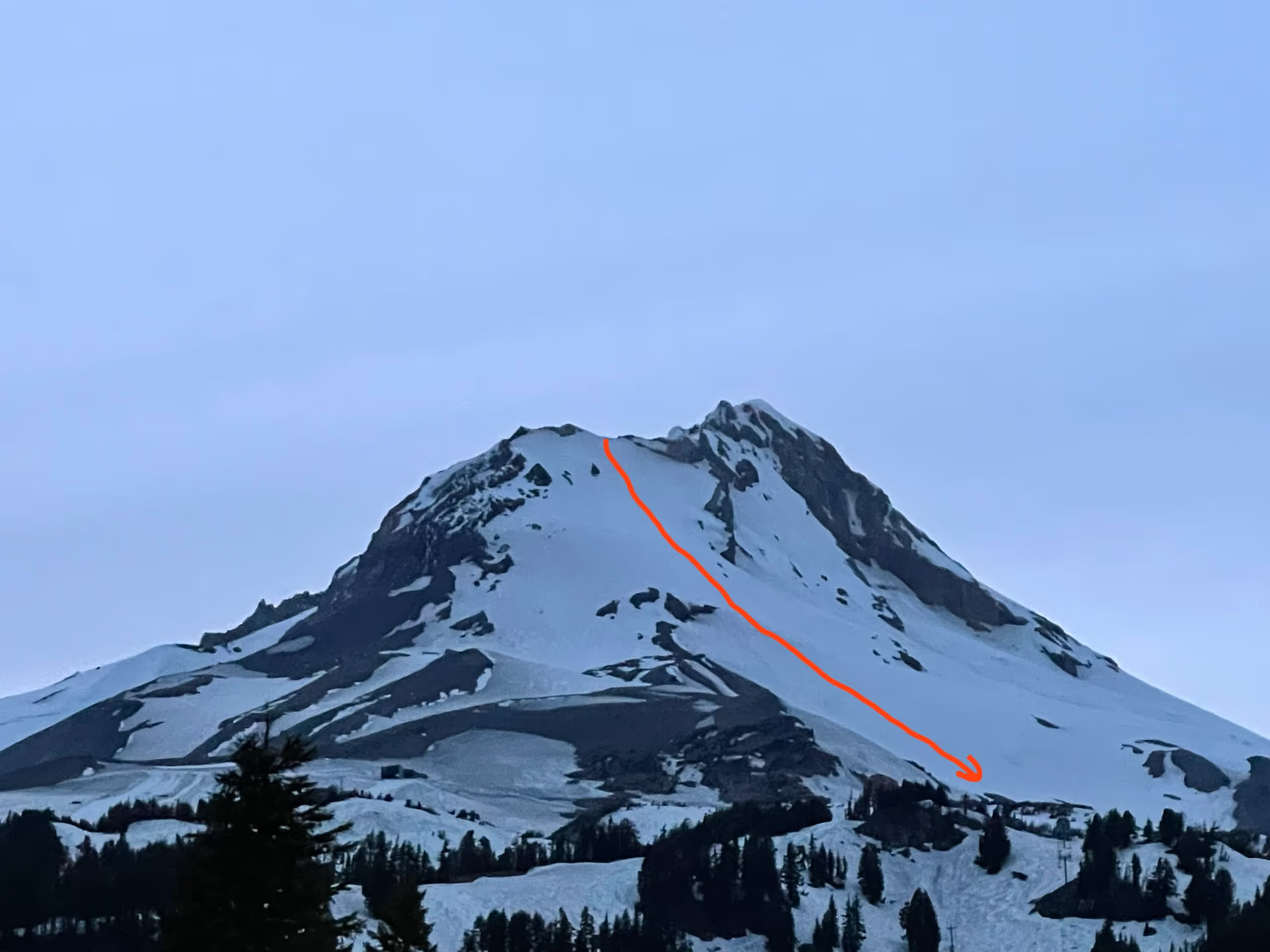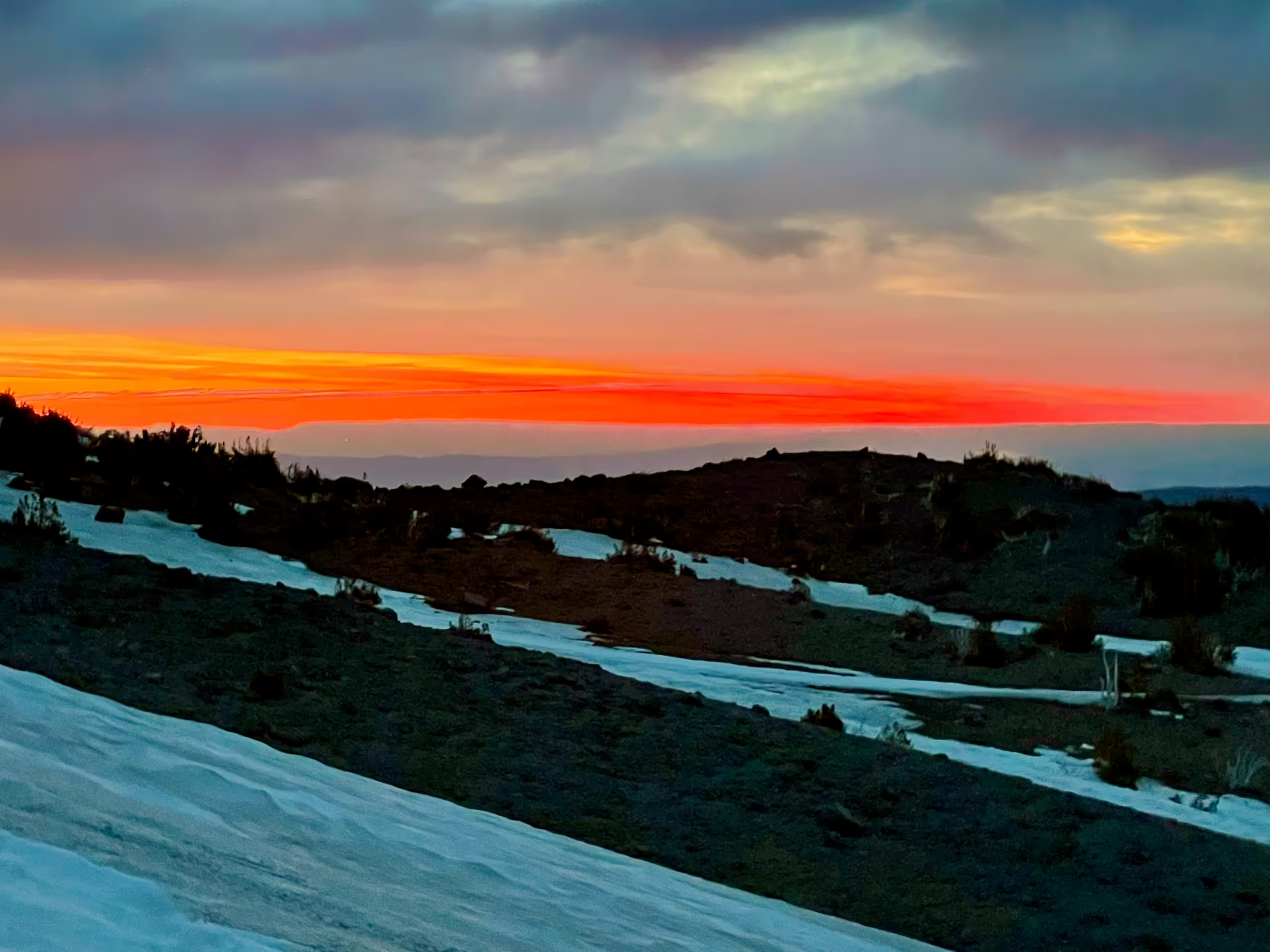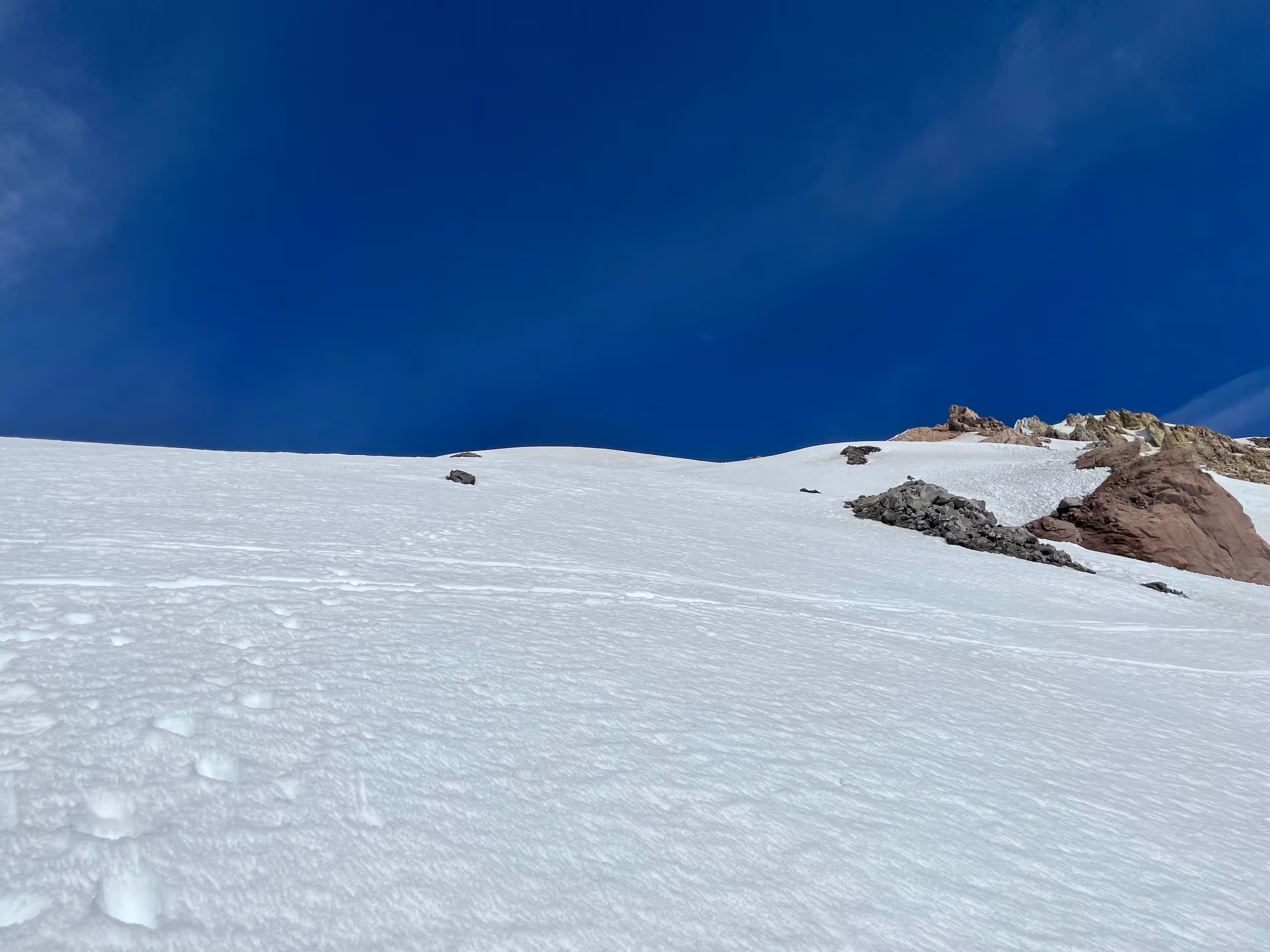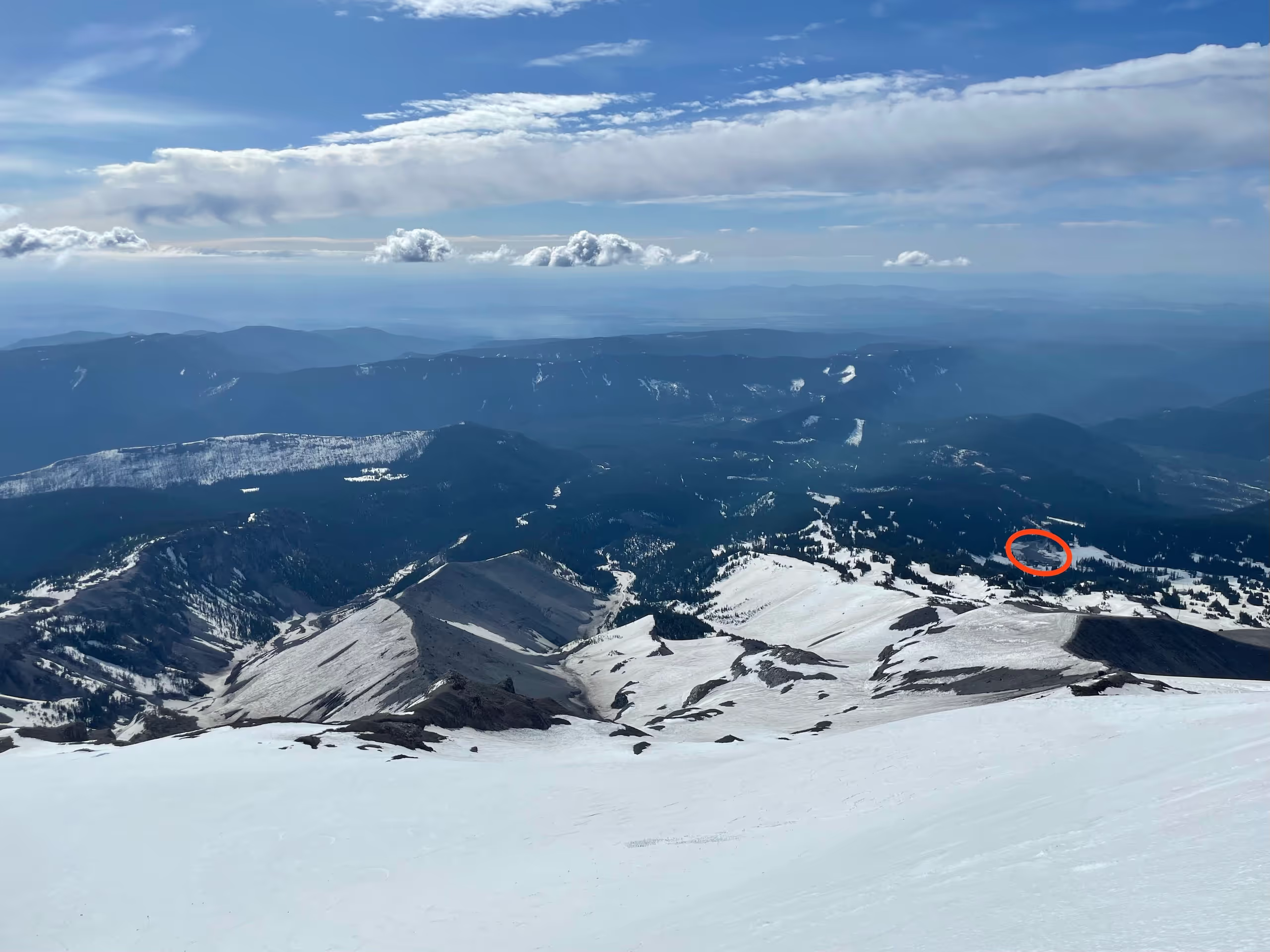
Mark Cohen, June 1, 2021
Wy'east - better known by its colonizer name, Mount Hood - is an 11249' stratovolcano situated just southeast of Portland, OR, in the Cascade Arc. Towering over the surrounding landscape, its comparatively high elevation and relatively low bar to entry made it an attractive objective for my first real ski mountaineering objective. A route called the Wy'east face (yes, the naming is redundant) begins from a ridgeline about 500' below the summit, presenting a continuous ski descent of about 5400'. The first 2500' - shown by the red line below - are a gorgeous, wide open face at a sustained 35 to 40 degrees of steepness.

So clearly, this ski descent is a huge payoff. But payoffs like that don't come easy in the world of ski mountaineering. Before setting out on this trip, my climbing partner Sheel and I had to do a lot of research and planning.
First and foremost, we had to assess what kind of gear and experience would be required for the ascent, and what kinds of hazards and obstacles we might encounter. Glaciated volcanoes like this usually present glacial hazards: crevasses and serac falls are deadly features that require specific mitigation and rescue training, training neither Sheel nor I have. Fortunately, the Wy'east face is free of these hazards - there are some small crevasses elsewhere on the mountain, but not on this route. Additionally, at no point does the ascent necessitate climbing with a rope & harness - more experience we don't have. From a technical perspective, this route is an ordinary backcountry ascent, just very, very long.
There are several highly restrictive factors to climbing this route. First, terrain of this nature is extremely dangerous to traverse in the winter - the avalanche danger is way too high, and deep snow makes the ascent much more physically demanding. The safer way to climb is to wait until spring, when the snowpack sinters enough to be essentially uniform, posing no avalanche danger (mostly - see the aside below) and providing a firm surface for easier climbing. Unfortunately, that's in direct conflict with the snow conditions you want for skiing. But with the right weather patterns, the snowpack will enter a melt-freeze cycle, freezing at night and then melting during the day. So the idea is to wait for several days of stable and warm weather, climb while the snow is still mostly frozen, and then ski right as it starts to melt.
This type of snow - that is, "melt" part of the melt-freeze cycle - is known as "corn snow", and is generally the best for spring skiing. You additionally need to be sure to catch just the beginning part of the melt phase: as the snow continues to heat, the slope will start to release loose wet avalanches, which while generally not deadly are still a significant hazard on a slope this big.
By far the most restrictive factor for climbing this route is the aspect: it faces southeast with zero shelter. This means that it gets direct solar exposure immediately at sunrise, and melts very quickly.
These factors together mean that the slope has to be skied between approximately 9am and 11am, with very little leeway on either side. The climb is approximately 4 miles long and 5400' of elevation gain. We estimated that it would take 6 hours for us to climb, which meant departing our campsite at around 3am.
We camped just outside the parking lot of the closed Mount Hood Meadows ski resort, pitching our tent right around sunset at 8:30pm and turning in for the night shortly after. We met one other party who were planning to ski the steeper and more demanding Newton Clark Headwall, which is visible in the photo at the top of this post, separated from the Wy'east face by the vertical rock band to looker's right of the red line. Sheel slept like a rock (he normally sleeps from 8pm to 4am, so this wasn't very weird for him), and I somehow didn't sleep a single minute. I laid in the tent for five hours with my eyes closed, completely awake the entire time.
As you might imagine, starting our ascent in the dark with zero sleep was absolute hell. I felt like death; I wanted to lay down on the mountain and go to sleep. My body felt leaden, and every step felt like at least twice the usual effort, despite my ultra lightweight kit. I trudged on for a couple hours, lit only my headlamp, feeling seeds of doubt creep in. If I'm this exhausted already, what chance do I stand to complete the climb?
The first phase of our ascent was to skin through the closed resort. The sparse industrial lighting and empty lifts lent an eerie quality to the pre-dawn hours. But as the sun came out and we could put away our headlamps, I felt myself regaining energy and lightness. First light hit about 3/4 of the way to the top of the resort, and we caught a blazing sunrise from the top station of the highest lift. I don't think I'd ever seen colors like that before in my life; as incredible as the photo is, it doesn't do it justice.

The Cascade Express lift at Mount Hood Meadows tops out at 7300', putting us about 1/3 of the way done with our climb. Just above the lift was a small, triangular snow face, at the top of which sat a long ridge that would take us to the base of the upper mountain. We anticipated being able to continue skinning along this ridge, but found that the snow fields had melted out to below the crest, leaving us to walk with skis on packs most of the way.
Walking along this ridge was utterly surreal. It felt like another planet: the volcanic rock underneath felt like Mars, and the ancient lava flows had carved these beautiful, dramatic canyons into the side of the mountain, receding into the foothills below.
It was here that I realized I fucked up. As you can see at the end of this video, my helmet doesn't have a GoPro mount. I had planned to capture most of the descent by helmet cam, but I brought a different helmet than usual; my usual helmet is great for downhill skiing, but offers no protection from overhead rock fall. So I brought a dual-certified helmet for this trip and forgot to stick a GoPro mount on it. 🙃
The ridge gradually petered out, leaving us to alternate between skinning and booting for a little while. The snow surface was pretty punishing - high winds during the day and a steady melt-freeze cycle had created huge sastrugi about 6 inches in height, which made skinning rather difficult. At some point in this transitional zone between the ridge and the upper mountain, we made one bad routefinding decision that ultimately prevented us from summitting.
Essentially, we wanted to continue skinning for as long as possible, as skinning is less physically demanding than bootpacking (walking straight uphill with skis on packs). We knew we would have to bootpack with crampons and ice axes for at minimum the last 1000', so we wanted to get as high up on skins as possible to conserve energy.
We thought we saw a small roll in the terrain which would provide a bit of a break from the otherwise-uniform steepness, allowing us to set our packs down and transition to bootpacking in comfort. However, as we pressed on, we realized that this roll was something of a mirage, and we ended up stuck on a completely uniform 40 degree face with nowhere to transition.

We couldn't make a kickturn to go back to where we had come from, and there was no shelter we could see in front. There was nowhere to go but straight up. By this point the snow had just begun to soften, so I dug a small dent in the surface with my hands to set my pack down securely. I balanced all my weight on my uphill ski, and then carefully bent down and removed my downhill ski. I impaled it in the snow so it wouldn't fly away, then removed one crampon from my pack, bent down again, and fastened it to my boot. Then I kicked that boot into the face at a 90 degree angle to my uphill ski, shifted my weight to the boot, swung my uphill ski out and around 180 degrees, set it down, and repeated the process for the other foot. I strapped my skis together, strapped them to my pack, got my ice axe out, got my helmet on, and was ready to go in just a few minutes.
I was honestly proud of this transition - I was nervous as I went through these careful motions, because if I managed to slip, I would've slid probably 1500' down the face unless I could self-arrest.
Once I finished my transition, I looked down to see Sheel still struggling. I downclimbed to him and found that he was having trouble getting his crampons to stay on his boots. He would fasten them up just fine, but then as soon as he tried to kick into the snow, the crampon would detach as if it was spring-loaded. We're still not sure what happened - my best guess was the piece holding the tension strap had gotten messed up in his pack, and couldn't absorb the force as it should.
I could see Sheel starting to get visibly scared - his hands and legs started trembling after about 10 minutes of troubleshooting. On top of the long exposure underneath us, only the very surface of the snow had begun to soften, so without crampons on he could only kick about 2 inches of the toe of his boot into the snow, leaving the rest of his foot just hanging over air, which you can see in this clip.
We stood kicked into this face troubleshooting Sheel's crampons for about half an hour and couldn't really get anywhere. Had we been on flatter ground we might've been able to partially disassemble and rebuild the tension straps, but the risk of a piece flying away was too high on that face. Eventually, I made a bit of a unilateral decision to bail. I knew Sheel would want to figure it out and push on to the top, but we were already inside the ski window - at about 9:15am I started noticing some periodic small (bowling ball sized) rock fall around us. Even if we figured out the crampons just then, we would've had to bootpack 900' in 30 minutes, then immediately turn around and ski fast to get off the upper mountain before rock fall and wet loose avalanches became a real hazard, which just wasn't going to happen. Below, you can see a reasonably well-established bootpack above us that another party must have put in earlier in the week.

Realizing this was our summit point, I took a few photos including this lovely shot of the lava canyons I mentioned earlier. Way at the base you can see the parking lot where we started (for scale, that parking lot is absolutely enormous - about half a mile end-to-end).

I undid my transition, following the same careful procedure in reverse. Sheel did as well. Despite not making the top of our planned route, we were brimming with excitement at the skiing below us - we still had about 2500' of excellent snow quality on a uniform steep face, followed by a long traverse back into the resort, and then some fun, weird skiing through the slushy slopes of Mount Hood Meadows. I had never ridden anything this big before.
Sadly, thanks to the aforementioned lack of a GoPro mount, the only skiing footage I have are some janky handheld shots that Sheel and I took of each other.
As we got lower in elevation, the snow quality started to degrade, getting dirtier, wetter, and stickier. The skiing wasn't pleasant, but it sure was an adventure.
I don't have any footage from inside the resort, because by then I just wanted to get back to the car. My legs were on fire, and the sleep deprivation and exhaustion were starting to catch up with me. We made one wrong turn and ended up over the wrong half of the resort, and had to skin back up another couple hundred feet. It tickled me using the resort signage to navigate with no one else around. And as we got back under the empty lifts, the eerie feeling from the pre-dawn hours was replaced by a gleeful nostalgia. I rode all the way down to the parking lot with a smile on my face, soaking up the last minutes of sun. In all, the descent took about two hours, at least half of which was eaten up by the traverse back to the top of the resort and the brief skin.
Reflecting on this day, I've settled on two lessons to take with me. The first is that success in the mountains is not defined by reaching your target, but by coming home safely. The day was a success by all measures; it was both the biggest climb and the biggest ski descent of my life. We made it back with no injuries and no close calls. We exercised (mostly) good judgment throughout the day and kept ourselves safe. We communicated well throughout the day, and when our one bad decision got us into a sticky situation, we slowed down and made the right calls. I'm happy with myself for embodying this lesson; I didn't need to convince myself that we had succeeded despite not reaching the top, I already felt triumphant as we walked back across the parking lot.
The second lesson is that I'm ready for more. Though the climb left me fairly exhausted, I still felt like I could do more. Had we not had to contend with the crampon fiasco I certainly could've made it to the top, possibly still with energy to spare. Plus, I was running on no sleep, and I'm in really bad physical shape right now - I've been terrible about exercising lately and other than about two dozen days of backcountry skiing this season, I've barely managed to take a walk most days and I've run maybe a dozen times. (Sheel, on the other hand, is an absolute monster: he runs at least 10 miles a day every day and is currently prepping for a 200k - yes, 200k, not 20k, that's not a typo.)
All in all, I'm overjoyed with how this trip went. It was a gratifying and fitting end to my first season living in the Pacific Northwest, and I hope it portends many more big climbs.
If you made it this far, thanks for reading!
✌️